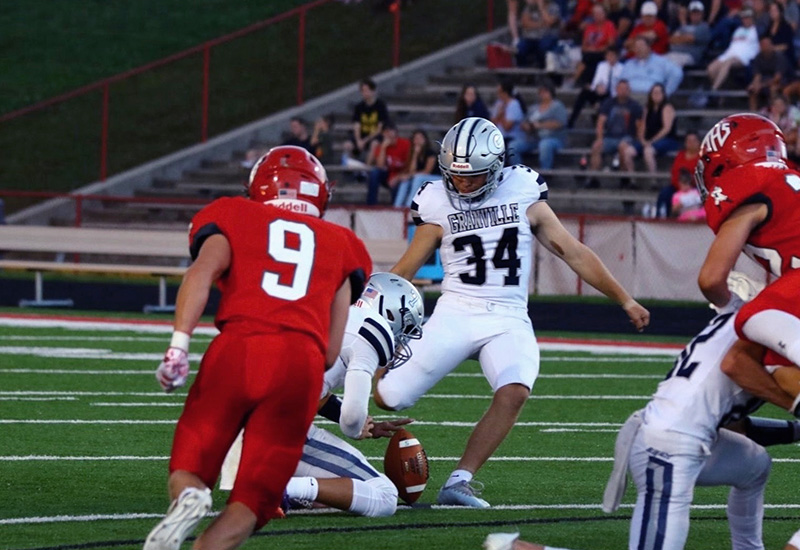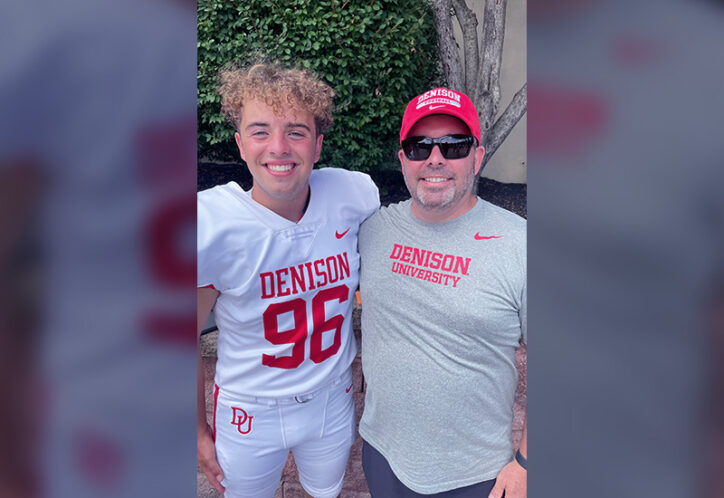Back from the bench: How my AVM was a new beginning

It’s crazy how something you once thought was the worst thing that could ever happen to you turns out to be one of the best. My AVM is one of those things.
My name is Davidson Jump. I’m from a small town in Ohio where football — high school football especially — is a big deal. At least it was to me. I’d been a lineman as long as I can remember, and, up until four-and-a-half years ago, I felt pretty good about my chances of making the high school team. But then, one day in eighth grade, everything changed.
Something wasn’t right
On March 6, 2018, I started feeling uneasy in school. It’s not like me to stand up and make a scene, but I knew I needed help. I had spots in my vision and then couldn’t see at all. I had had a grand mal seizure. My classmates and teacher rushed to help me. I was brought by ambulance to a major medical center about an hour from my house where the care team told me and my parents that it’s not terribly uncommon for kids my age to experience a random and isolated seizure. My parents weren’t satisfied with that answer, though, and insisted I get an MRI. Because it wasn’t deemed necessary for my care, it took almost two months to schedule a scan. I’m forever thankful that my parents insisted I get an MRI because the results showed I had a partially ruptured arteriovenous malformation (AVM). Essentially, I was a ticking time bomb.
Looking for a champion
An AVM is an abnormal connection between arteries and veins in the brain that creates a cluster of blood vessels. If the cluster ruptures, it can bleed into the brain and can potentially be fatal. The best treatment option is surgical removal.
The problem, though, is that AVMs are pretty rare, so few places are experienced in removing them. My parents and I looked endlessly to find someone with extensive experience and finally found Dr. Edward Smith and the Cerebrovascular Surgery and Interventions Center at Boston Children’s Hospital.
I liked Dr. Smith as soon as I spoke to him, and just based on the number of AVMs he and this team have treated, we knew Boston was where we wanted to be.
My Independence Day
Just days before the Fourth of July, I flew to Boston with my family to have my AVM embolized and surgically removed. Embolization is a noninvasive procedure that blocks or closes a blood vessel. Dr. Smith said that what I had was a complicated AVM, meaning it spanned from the surface of my brain into the ventricles, so being able to embolize it before surgery helped to slow down the blood flow and improve the chances of safely removing it entirely. Which he did.
An upside-down world
I was discharged home about a week later, which is when the real work began. Although the procedure was a success, the trauma to my brain left me with a blind spot and pure alexia, which is an impairment that causes the inability to read. I had to learn to read again and slowly adjusted to living with my blind spot. It made things easier that I got great support through speech and occupational therapy, and the counselors and staff at school, but what I struggled with most was not being able to play football. Because the risk of injury to my head was too great to go back to being a lineman, it looked like my football career was over before it ever really began, and I was crushed.
Finding a new approach to the game
I started my freshman year of high school watching football from the sidelines. All I wanted was to be part of the team.
At my check-up that fall, I mentioned to my pediatrician how much I missed football.
“Why do you go out and try to kick?” she suggested. The idea had never occurred to me, and although I had no experience being a kicker, I was up for the challenge. Even better, Dr. Smith was OK with it. Once I started kicking the ball, I immediately fell in love with it.
Playing on my high school’s football team was one of the greatest experiences of my life.
I’ll never forget what my dad told me right before the season opener of my senior year:
“When you’re out there,” he said, “take your steps and get ready but before you start, just look. Look at everybody, take it all in, just for a second.” That’s what I did, and I’m hoping to always hold on to the awe I felt in that moment.
Sharing my story

Today, I’m a kicker at Denison University, where I’m majoring in Health, Exercise and Sport Studies. I’m also a youth ambassador for The Aneurysm and AVM Foundation where I connect with people who have lost loved ones, have been recently diagnosed, or have had surgery for AVMs. It’s important for me to share my story because, besides my kicking journey, coming back from my AVM is one of the things I’m most proud of. I know it can be hard to find people who have had the same experience, so if someone’s going through a similar diagnosis or has lost someone, I want them to know there are people who can relate and who they can talk to. I don’t want them to walk alone.
Learn more about the Cerebrovascular Surgery and Interventions Center.
Related Posts :
-

Jack: My AVM story
Last spring, during my junior year of high school, I had a head collision during rugby practice. My coach recommended ...
-

Back from the brink: How Boston Children’s saved my life
I was first rushed to Boston Children’s Hospital on my very first night of summer vacation in June 2015. I ...
-

'To do what’s best for Marley': One family’s experience with a vein of Galen malformation
Last summer, Savannah and Brian were eagerly awaiting the birth of their first child. Savannah was scheduled to deliver their ...
-

Answers for Isaac: A family’s journey to treat vascular anomalies
Early on, Jinah and her husband knew their son Isaac was battling something complex, but they couldn’t figure out ...





